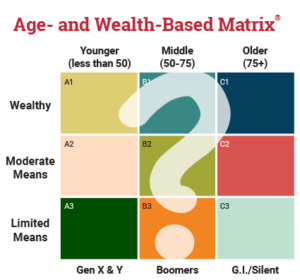We are often asked by our clients which channel (print or digital) is the most effective way to identify and attract planned giving donors.
Let’s answer that question with a question: Who remembers the Saturday Night Live “New Shimmer” skit with Chevy Chase? Is it a floor wax? Is it a dessert topping? It’s both!

Who’s your audience?
When planning a communications strategy, the most important thing to keep in mind—budgets aside—is who is your target audience? For example, we know that the primary group to target for bequest marketing are those in their 70s or older. These are people who did not grow up with the internet or a smartphone and likely never used computers in school or even at work.
So, it is safe to say most current prospective bequest donors will not be reached solely using a digital strategy. Print communications are still needed if you want to reach older donors. Traditional print, such as a quarterly newsletter with a donor story and a response card, continues to prove most effective in generating responses and motivating completed gifts for many Sharpe clients.
The digital approach
Digital communications can certainly be more cost effective, especially for organizations with tight marketing budgets, as there are no printing or postage costs.
Emails can be used as a way to encourage a donor to quickly make a gift (which may be particularly helpful during your year-end communications), easily request additional information or to drive traffic to your planned giving website. Many Sharpe newsletter clients also send a digital version in order to reach a broader audience.
The best communication method
Both digital and print marketing are important elements of an overall strategy, with different objectives, contexts and target audiences. To be truly effective, the multi-channel approach is needed. Finding the right balance between print and digital and knowing your donors will be the keys to overall success. ■

